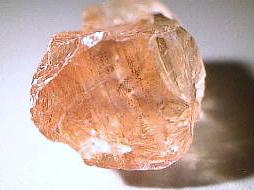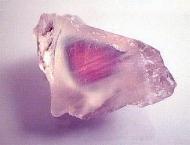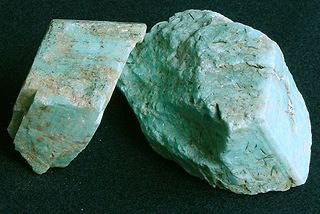
Amazonite, also known as Amazonstone, is a green tectosilicate mineral, a variety of the potassium feldspar called microcline. Its chemical formula is KAlSi3O8, which is polymorphic to orthoclase.

Amblygonite is a fluorophosphate mineral, (Li,Na)AlPO4(F,OH), composed of lithium, sodium, aluminium, phosphate, fluoride and hydroxide. The mineral occurs in pegmatite deposits and is easily mistaken for albite and other feldspars. Its density, cleavage and flame test for lithium are diagnostic. Amblygonite forms a series with montebrasite, the low fluorine endmember. Geologic occurrence is in granite pegmatites, high-temperature tin veins, and greisens. Amblygonite occurs with spodumene, apatite, lepidolite, tourmaline, and other lithium-bearing minerals in pegmatite veins. It contains about 10% lithium, and has been utilized as a source of lithium. The chief commercial sources have historically been the deposits of California and France.
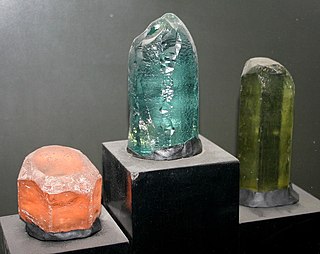
Beryl ( BERR-əl) is a mineral composed of beryllium aluminium silicate with the chemical formula Be3Al2Si6O18. Well-known varieties of beryl include emerald and aquamarine. Naturally occurring, hexagonal crystals of beryl can be up to several meters in size, but terminated crystals are relatively rare. Pure beryl is colorless, but it is frequently tinted by impurities; possible colors are green, blue, yellow, pink, and red (the rarest). It is an ore source of beryllium.

Sapphire is a precious gemstone, a variety of the mineral corundum, consisting of aluminium oxide (α-Al2O3) with trace amounts of elements such as iron, titanium, cobalt, lead, chromium, vanadium, magnesium, boron, and silicon. The name sapphire is derived via the Latin "sapphirus" from the Greek "sappheiros", which referred to lapis lazuli. It is typically blue, but natural "fancy" sapphires also occur in yellow, purple, orange, and green colors; "parti sapphires" show two or more colors. Red corundum stones also occur, but are called rubies rather than sapphires. Pink-colored corundum may be classified either as ruby or sapphire depending on locale. Commonly, natural sapphires are cut and polished into gemstones and worn in jewelry. They also may be created synthetically in laboratories for industrial or decorative purposes in large crystal boules. Because of the remarkable hardness of sapphires – 9 on the Mohs scale (the third hardest mineral, after diamond at 10 and moissanite at 9.5) – sapphires are also used in some non-ornamental applications, such as infrared optical components, high-durability windows, wristwatch crystals and movement bearings, and very thin electronic wafers, which are used as the insulating substrates of special-purpose solid-state electronics such as integrated circuits and GaN-based blue LEDs. Sapphire is the birthstone for September and the gem of the 45th anniversary. A sapphire jubilee occurs after 65 years.
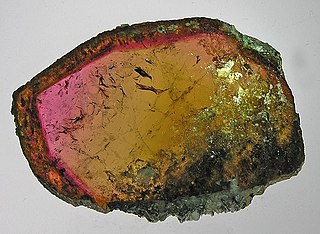
Tourmaline is a crystalline silicate mineral group in which boron is compounded with elements such as aluminium, iron, magnesium, sodium, lithium, or potassium. This gemstone comes in a wide variety of colors.
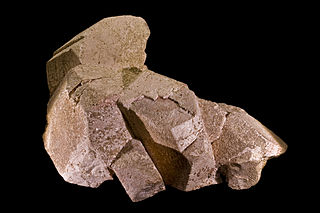
Orthoclase, or orthoclase feldspar (endmember formula KAlSi3O8), is an important tectosilicate mineral which forms igneous rock. The name is from the Ancient Greek for "straight fracture", because its two cleavage planes are at right angles to each other. It is a type of potassium feldspar, also known as K-feldspar. The gem known as moonstone (see below) is largely composed of orthoclase.

Turquoise is an opaque, blue-to-green mineral that is a hydrous phosphate of copper and aluminium, with the chemical formula CuAl6(PO4)4(OH)8·4H2O. It is rare and valuable in finer grades and has been prized as a gemstone for millennia due to its unique hue.
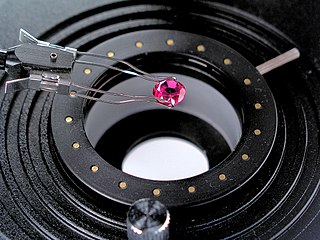
Gemology or gemmology is the science dealing with natural and artificial gemstone materials. It is a geoscience and a branch of mineralogy. Some jewelers are academically trained gemologists and are qualified to identify and evaluate gems.

Tanzanite is the blue and violet variety of the mineral zoisite, caused by small amounts of vanadium. Tanzanite belongs to the epidote mineral group. Tanzanite is only found in Simanjiro District of Manyara Region in Tanzania, in a very small mining area approximately 7 km (4.3 mi) long and 2 km (1.2 mi) wide near the Mererani Hills.

In gemology, aventurescence is an optical reflectance effect seen in certain gems. The effect amounts to a metallic glitter, arising from minute, preferentially oriented mineral platelets within the material. These platelets are so numerous that they also influence the material's body colour. In aventurine quartz chrome-bearing fuchsite produces a green stone, and various iron oxides produce a red stone.

Demantoid is the green gemstone variety of the mineral andradite, a member of the garnet group of Minerals. Andradite is a calcium- and iron-rich garnet. The chemical formula is Ca3Fe2(SiO4)3 with chromium substitution as the cause of the demantoid green color. Ferric iron is the cause of the yellow in the stone.

The Gemological Institute of America (GIA) is a nonprofit institute based in Carlsbad, California. It is dedicated to research and education in the field of gemology and the jewelry arts. Founded in 1931, GIA's mission is to protect buyers and sellers of gemstones by setting and maintaining the standards used to evaluate gemstone quality. The institute does so through research, gem identification and diamond grading services and a variety of educational programs. Through its library and subject experts, GIA acts as a resource of gem and jewelry information for the trade, the public and media outlets.
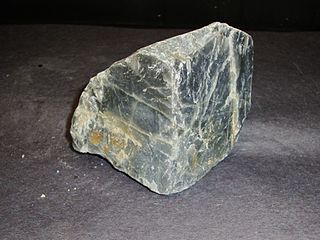
Andesine is a silicate mineral, a member of the plagioclase feldspar solid solution series. Its chemical formula is (Ca, Na)(Al, Si)4O8, where Ca/(Ca + Na) (% anorthite) is between 30 and 50%. The formula may be written as Na0.7-0.5Ca0.3-0.5Al1.3-1.5Si2.7-2.5O8.

Spessartine is a nesosilicate, manganese aluminium garnet species, Mn2+3Al2(SiO4)3. This mineral is sometimes mistakenly referred to as spessartite.

Tairus is a synthetic gemstone manufacturer. It was formed in 1989 as part of Mikhail Gorbachev's perestroika initiative to establish a joint venture between the Russian Academy of Sciences and Tairus Created Gems Co Ltd. of Bangkok, Thailand. Today Tairus is a major supplier of hydrothermally grown gemstones to the jewellery industry. Later, Tairus became a privately held enterprise, operating out of its Bangkok distribution hub under the trade name Tairus, owned by Tairus Created Gems Co Ltd. of Bangkok, Thailand.
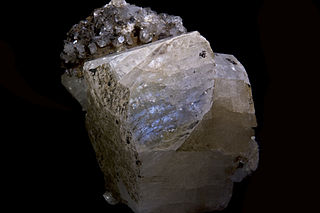
Moonstone is a sodium potassium aluminium silicate ((Na,K)AlSi3O8) of the feldspar group that displays a pearly and opalescent schiller. An alternative name for moonstone is hecatolite.

Adularescence is an optical phenomenon that is produced in gemstones like moonstone. The optical effect is similar to labradorescence and aventurescence.
Richard T. Liddicoat, Jr. was an American gemologist. Liddicoat was an educator in gemology, who also made contributions in the area of diamond quality grading and gem identification. Liddicoat was the Chairman of the Board of Governors at the Gemological Institute of America (GIA).
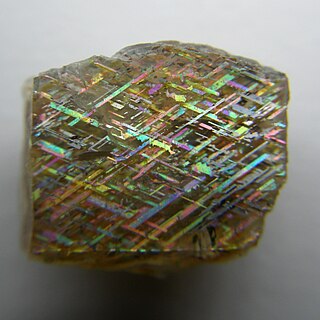
Rainbow lattice sunstone, also known as rainbow lattice, is a type of orthoclase feldspar that exhibits a rare combination of aventurescence, adularescence, and a distinctive iridescence lattice pattern. The iridescence lattice pattern consists of inclusions that are the result of crystallographically oriented exsolution crystals within the feldspar crystal. Sunstone refers to its physical appearance instead of its chemical composition.
